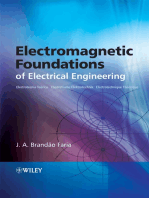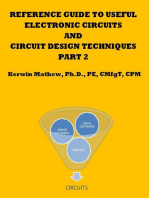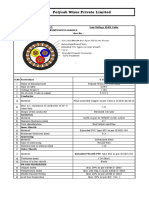Lab Report 7
Uploaded by
ung65014Lab Report 7
Uploaded by
ung65014Addis Ababa University
Faculty of Technology
Department of Electrical and Computer Engineering
Laboratory Report
Course number: Eceg:- 2205 - Electrical Engineering Laboratory II
Experiment Number: 07
Title: The Transistor as an Amplifier
ICE
AC load line of a transistor
DC load line of a transistor
ICEQ
Cut-off
Region
Saturation VCEQ VCE
Region
Region
Figure A: Output Graph for The Bipolar Junction Transistor
Region
By: Besufekad Mekuria
Group: 1B, Subgroup 5, ID: TCR/0590/01
Date of Lab. session: December 23, 2009
Date of submission: December 30, 2009
AAU, FACULTY OF TECHNOLOGY, DEPARTMENT OF ELECTRICAL ENGINEERING, LABORATORY REPORT 0
TABLE OF CONTENTS:
Section Sub-Title Location
NO
1.1 Introduction Page Two
1.2 Objective Page Two
1.3 Preparation Page Two
1.4 Used Equipment Page Two
1.5 Components used Page Two
1.6 Theory Page Three
1.7 Procedure Page Three
1.8 Calculations Page Four
1.9 Results Page Five
1.10 Conclusion Page Thirteen
AAU, FACULTY OF TECHNOLOGY, DEPARTMENT OF ELECTRICAL ENGINEERING, LABORATORY REPORT 1
Transistor as an amplifier
1.1 INTRODUCTION
Transistors have many uses, among this are: its use as a switch, and also its Input signal
Amplification. Transistors require proper biasing to operate normally, the emitter-base junction should
be forward biased and the collector-base junction should be reverse biased.
1.2 OBJECTIVE
A. To observe the input voltage amplification characteristics of the transistor.
B. To develop the skill of using this amplifying circuit to help in designing our own amplifier circuits
in the future.
1.3 PRE-LAB PREPARATION
All the calculations and their corresponding theories have been dealt with prior to entering the
laboratory, and each is shown in the respective calculations and theory part.
1.4 USED EQUIPMENT
No Description Code/Lab Reference Quantity
1 DC Power supply 9V 1
2 Multi-meter (VOM) - 1
3 Cathode Ray oscilloscope - 1
4 Conducting Wires - 13
5 Function Generator - 1
Table 1: Electrical Equipments that were used to set up the circuit for the laboratory procedure
1.5 USED COMPONENTS
No Description Type Quantity
1 Resistor 56K Ω 1
2 Resistor 120K Ω 1
3 Resistor 27 K Ω 1
4 Resistor 1 MΩ 1
5 Capacitor 10 μF 2
5 Capacitor 200 μF 1
6 Resistor Variable 1
Table 2: Electrical Components that were used to set up the circuit for the laboratory procedure
AAU, FACULTY OF TECHNOLOGY, DEPARTMENT OF ELECTRICAL ENGINEERING, LABORATORY REPORT 2
1.6 THEORY
To obtain maximum performance from a transistor, it has to be forward Biased, this is due to reasons
described in the last laboratory session (refer to laboratory session 6).
However, two reasons must be considered:
1. There is a wide range of characteristics within transistors having the same type number
2. The behavior of the transistor varies considerably with changes in temperature.
Other stabilizing methods are utilized, therefore, the operating point is defined where it should be
constant, is determined by these factors:
a. The Q point is selected in such a way that linear operation is maintained.
b. Then, the Q point is made not to exceed its ratings.
c. Thirdly, the Q point is configured so as the parameters of the small signal transistor are kept more
or less constant.
ICE
AC load line of a transistor
DC load line of a transistor
ICEQ
Cut-off
Region
Saturation VCEQ VCE
Region
Region
Figure 1: First Order Resistive - Capacitive Network
Region
1.7 PROCEDURE
The Procedures were carried out in accordance to the lab manual.
5.1 Using the following values, the magnitudes of R V until a value of 3.5V is obtained between
the emmiter and the collector (VCE), which happenes when Ic is 2Vpp,
Then, es was adjusted to obtain e0 = 0.2Vpp, and es and ei were recorded. And the procedure
was repeated for e0 = 0.3 and 0.4 VPP
AAU, FACULTY OF TECHNOLOGY, DEPARTMENT OF ELECTRICAL ENGINEERING, LABORATORY REPORT 3
5.2 The DC potential was measured at the base, the emitter and the collector were measured
using the VTVM, while switching Rs =Rs1, Rc=Rc2.
5.3 A 1 KHz signal (es) was applied while making sure that the e0 doesn’t exceed 1 Vpp, the
corresponding values of es, ei and eo were recorded.
5.4 The output Resistance of the amplifier was determined while opening the circuit at RL (RL =
∞) and also setting it to 3.9Kohms.
1.8 Calculations
All of the necessary calculations required in the lab session are as follows:
Ei = Hie Ib + Hie*e0
Ic = Hfe Ib + H0e*e0
Hie = rb + (B+1)re
Hfe – Brd / (rd + re)
Hre = re / (rd + re)
Hoe = 1 / (rd + re)
Rb = -R1 //R2 and Rac = Rc//Rl
Eo- = -Hfe Ib * (Rac // 1/hoe)
= -Ib Hfe Rac / (1 + hoe Rac)
Ei = Ib(Hie – Hre Hfe / (1 + hoe Rac))
Thus The Voltage Gain of the amplifier becomes:
Av = eo/ei = - Hfe Rac / (Hie + (Hie Hoe – Hfe Hre)Rac)
Av = -Hfe Rac /Hie By Approximation
AAU, FACULTY OF TECHNOLOGY, DEPARTMENT OF ELECTRICAL ENGINEERING, LABORATORY REPORT 4
1.10 Conclusion
To briefly restate the main concepts we grasped upon completion of the laboratory session, we were able
to understand many things, each will be discussed under its own title.
Observations made about Amplification properties of transistors
The Transistor can be used as an amplifier when biased accordingly in the forward biased
situation.
Observations made about Structural composition of transistors
The Transistor is composed of three major parts in the semiconductor matrix, these are: The Emitter,
the Base and the Collector. All of the input and output characteristics of the network can be measured
by connecting the appropriate measuring meter as shown by the circuit diagram figure (A).
Although it wasn’t part of the procedure, our instructors have demonstrated to us that a special kind
of Oscilloscope can be used to depict the VCE versus ICE Graph.
Observations made about the Ratings of the Transistor
For the proper functioning of the Transistor, certain values of current and voltage (also inherently,
power) should not be surpassed. These values are called: Current Rating, Voltage Rating and Power
rating respectively. And even though the values weren’t imprinted on the transistor we worked on, the
laboratory manual we used instructed for us not to surpass the following value, so, this value can be
considered as the Current Rating value,: IB = 250µA.
Observations made about the Amplification properties of the Transistor
Transistors can be used to amplify voltages, as observed from the laboratory session, the gain of 40,
implies that the input voltage has been magnified 40 times, and hence the transistor has been used as
an Amplifier.
Observations made about practical errors
As it is a known fact, there does not exist a circuit element that functions with a hundred percent
efficiency. Therefore slight deviations of the measured values from the calculated ones are to be expected under
any circumstances. However the possible causes for these irregularities include:
The DC voltmeter does not give rise to a potential difference with a magnitude that it is programmed to do.
This is generally due to manufacturing defects, defects from improper usage and gradual wearing off.
The leads are not of Zero Resistance; this is because of factors like: Temperature change, corrosion due to
exposure to Atmospheric Humidity, etc…
The Ammeter used was an analog device; therefore readings are perceptible to be misconstrued. And also
continuous mistreatment of the device leads to incorrect readings in the future.
End of Report
AAU, FACULTY OF TECHNOLOGY, DEPARTMENT OF ELECTRICAL ENGINEERING, LABORATORY REPORT 5
You might also like
- Do Not Do Error Analysis This Week, But Please Record Errors in Tables of Raw DataNo ratings yetDo Not Do Error Analysis This Week, But Please Record Errors in Tables of Raw Data2 pages
- Physics Investigatory Project Common Base TransistorNo ratings yetPhysics Investigatory Project Common Base Transistor13 pages
- Content Acknowledgement Objective Apparatus Diagram TheoryNo ratings yetContent Acknowledgement Objective Apparatus Diagram Theory12 pages
- LAB 2 Transistor Djm20042 Sesi1 2022.2023No ratings yetLAB 2 Transistor Djm20042 Sesi1 2022.202311 pages
- Common Emitter Amplifier: EE091 Electronic DevicesNo ratings yetCommon Emitter Amplifier: EE091 Electronic Devices8 pages
- Electronic Devices and Circuits Lab Manual PDFNo ratings yetElectronic Devices and Circuits Lab Manual PDF33 pages
- Experiment 16 Troubleshooting A CE Amplifier100% (1)Experiment 16 Troubleshooting A CE Amplifier12 pages
- Physics Investigatory Project Common Base TransistorNo ratings yetPhysics Investigatory Project Common Base Transistor12 pages
- Electronic Design Semiconductor Lab: TransistorsNo ratings yetElectronic Design Semiconductor Lab: Transistors10 pages
- Physics Investigatory Project - V.g.shreyas (1) - 3No ratings yetPhysics Investigatory Project - V.g.shreyas (1) - 316 pages
- Physics Investigatory Project Common Base TransistorNo ratings yetPhysics Investigatory Project Common Base Transistor12 pages
- BJT Common Emitter Characteristics: Experiment 6No ratings yetBJT Common Emitter Characteristics: Experiment 65 pages
- To Construct An Amplifier Using A Transistor50% (2)To Construct An Amplifier Using A Transistor37 pages
- Dechassa - Retta - Lemma - 3189815 - 22577354 - BEE 332# Due Nov 2 From Abraham.aNo ratings yetDechassa - Retta - Lemma - 3189815 - 22577354 - BEE 332# Due Nov 2 From Abraham.a33 pages
- Phy Inv Project - Common Base TransistorNo ratings yetPhy Inv Project - Common Base Transistor9 pages
- Reference Guide To Useful Electronic Circuits And Circuit Design Techniques - Part 2From EverandReference Guide To Useful Electronic Circuits And Circuit Design Techniques - Part 2No ratings yet
- Ceiling Fan With Permanent Magnet Generator: IJCRT2106128 International Journal of Creative Research Thoughts (IJCRT) b48No ratings yetCeiling Fan With Permanent Magnet Generator: IJCRT2106128 International Journal of Creative Research Thoughts (IJCRT) b484 pages
- Photovoltaic Connectors: Product Overview 2017/2018No ratings yetPhotovoltaic Connectors: Product Overview 2017/201828 pages
- Optimal Design of The Coils of An ElectrNo ratings yetOptimal Design of The Coils of An Electr4 pages
- Communication Protocols Devices Available in The MarketNo ratings yetCommunication Protocols Devices Available in The Market199 pages
- Automation That Keeps A Handle On System Protection and Control'No ratings yetAutomation That Keeps A Handle On System Protection and Control'2 pages
- Ajustable Precision Zenner Shunt Regulador LM 431No ratings yetAjustable Precision Zenner Shunt Regulador LM 43113 pages
- (1981) - Single Phase Switching Tests On The AEP 765 KVNo ratings yet(1981) - Single Phase Switching Tests On The AEP 765 KV7 pages
- Lesson Plan - Antennas & Wave Propagation (15EC604)100% (1)Lesson Plan - Antennas & Wave Propagation (15EC604)25 pages
- Implementationof Position Control Servo DCMotorwith PIDControllerto Humanoid Robot ArmNo ratings yetImplementationof Position Control Servo DCMotorwith PIDControllerto Humanoid Robot Arm7 pages
- Roxtec Cable Seals: For Power Transmission and Distribution ApplicationsNo ratings yetRoxtec Cable Seals: For Power Transmission and Distribution Applications24 pages
- An Active Two-Stage Class-J Power Amplifier Design For Smart Grid's 5G Wireless NetworksNo ratings yetAn Active Two-Stage Class-J Power Amplifier Design For Smart Grid's 5G Wireless Networks18 pages
- WebCatalog2004 MindControl Devices LaserNo ratings yetWebCatalog2004 MindControl Devices Laser34 pages
- Do Not Do Error Analysis This Week, But Please Record Errors in Tables of Raw DataDo Not Do Error Analysis This Week, But Please Record Errors in Tables of Raw Data
- Physics Investigatory Project Common Base TransistorPhysics Investigatory Project Common Base Transistor
- Content Acknowledgement Objective Apparatus Diagram TheoryContent Acknowledgement Objective Apparatus Diagram Theory
- Common Emitter Amplifier: EE091 Electronic DevicesCommon Emitter Amplifier: EE091 Electronic Devices
- Physics Investigatory Project Common Base TransistorPhysics Investigatory Project Common Base Transistor
- Physics Investigatory Project - V.g.shreyas (1) - 3Physics Investigatory Project - V.g.shreyas (1) - 3
- Physics Investigatory Project Common Base TransistorPhysics Investigatory Project Common Base Transistor
- Dechassa - Retta - Lemma - 3189815 - 22577354 - BEE 332# Due Nov 2 From Abraham.aDechassa - Retta - Lemma - 3189815 - 22577354 - BEE 332# Due Nov 2 From Abraham.a
- Electromagnetic Foundations of Electrical EngineeringFrom EverandElectromagnetic Foundations of Electrical Engineering
- Reference Guide To Useful Electronic Circuits And Circuit Design Techniques - Part 2From EverandReference Guide To Useful Electronic Circuits And Circuit Design Techniques - Part 2
- Ceiling Fan With Permanent Magnet Generator: IJCRT2106128 International Journal of Creative Research Thoughts (IJCRT) b48Ceiling Fan With Permanent Magnet Generator: IJCRT2106128 International Journal of Creative Research Thoughts (IJCRT) b48
- Photovoltaic Connectors: Product Overview 2017/2018Photovoltaic Connectors: Product Overview 2017/2018
- Communication Protocols Devices Available in The MarketCommunication Protocols Devices Available in The Market
- Automation That Keeps A Handle On System Protection and Control'Automation That Keeps A Handle On System Protection and Control'
- (1981) - Single Phase Switching Tests On The AEP 765 KV(1981) - Single Phase Switching Tests On The AEP 765 KV
- Lesson Plan - Antennas & Wave Propagation (15EC604)Lesson Plan - Antennas & Wave Propagation (15EC604)
- Implementationof Position Control Servo DCMotorwith PIDControllerto Humanoid Robot ArmImplementationof Position Control Servo DCMotorwith PIDControllerto Humanoid Robot Arm
- Roxtec Cable Seals: For Power Transmission and Distribution ApplicationsRoxtec Cable Seals: For Power Transmission and Distribution Applications
- An Active Two-Stage Class-J Power Amplifier Design For Smart Grid's 5G Wireless NetworksAn Active Two-Stage Class-J Power Amplifier Design For Smart Grid's 5G Wireless Networks

























































































